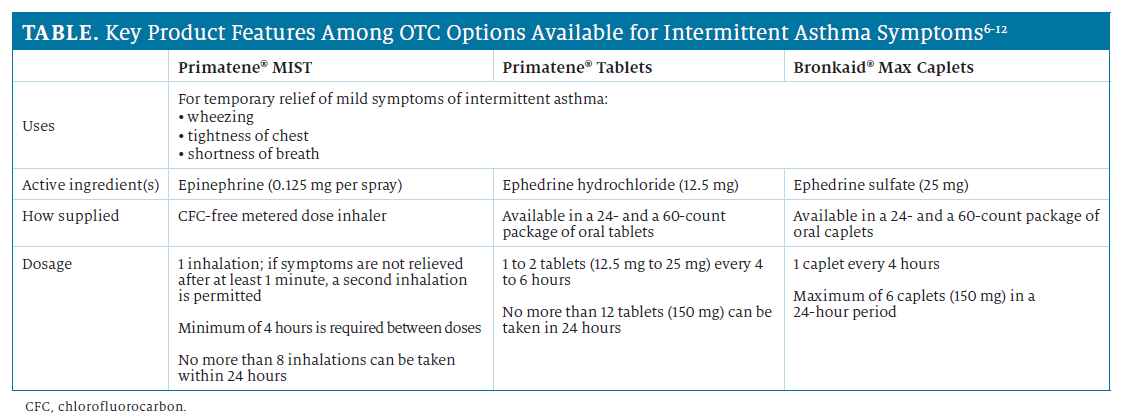Article
Role of OTC Asthma Medications in the Community Pharmacy
This article was sponsored by Foundation Consumer Healthcare.
Of the approximately 25 million Americans with asthma, 20 million are adults aged 18 years and older.1 Asthma severity is classified into 4 groups: intermittent, persistent-mild, persistent-moderate, and persistent-severe.2 In the United States, nearly 65% of adults have persistent asthma and 35% have intermittent asthma.3 Intermittent asthma is defined as acute or subacute bouts of gradually intensifying cough, chest tightness, wheezing, and shortness of breath for 2 or fewer days per week and awakening from these symptoms 2 or fewer times per month as recalled by the patient or caregiver.2
Although it is the least severe asthma classification, adults with intermittent asthma with mild symptoms are still at risk of asthma exacerbations (asthma attacks).2 Intermittent asthma is a chronic illness that usually requires ongoing management throughout adulthood for those who may have been diagnosed during childhood.2
As accessible health care professionals, pharmacists can recognize potential challenges and barriers to asthma care as well as provide counseling and access to OTC medications that are available for the management of mild symptoms of intermittent asthma.
BARRIERS TO ONGOING ASTHMA CARE IN SPECIFIC POPULATIONS
Patients with well-managed intermittent asthma typically receive an asthma management plan from their care team and appropriate prescription medicines. The goals of asthma management are to reduce asthma symptoms (eg, coughing, wheezing or shortness of breath at night, during the early morning, or after exertion), reduce the number of asthma episodes or attacks, prevent emergency health care visits, and reduce the need for quick relief therapy.2
However, not all patients who receive a diagnosis of intermittent asthma have access to ongoing medical care or prescription medications that are needed for the management of their condition.4 This population may not have adequate medical insurance coverage for regular visits to a pulmonologist or prescription drug coverage for needed prescription medications.4 Also, patients may not take their condition seriously, may not follow their treatment plan, or may forget to carry their rescue inhaler at all times.4
Intermittent asthma that is undertreated or not well-managed is associated with potentially serious health risks and substantial health care and financial burdens that impact those with asthma, their families, and the public health care system overall.4 Undertreated asthma can cause sleep disturbance, tiredness during the day, and poor concentration. Moreover, this can lead to missed days of school and work.5 The clinical and economic implications associated with asthma attacks can include increased patient morbidity and health care resource utilization (eg, emergency department visits, hospitalizations), which drive the total costs of asthma care.4
Asthma management plans should account for practical issues including cost, ability to use the medication (eg, inhaler technique and need for training), and adherence to and safety of medication regimens.4 As part of an individualized asthma management plan, there is an important role for safe and effective back-up options that are available over the counter, especially for those with access barriers, to provide temporary relief of mild symptoms of intermittent asthma.4
AVAILABLE OTC ASTHMA MANAGEMENT OPTIONS
As shown in the TABLE, there are 3 OTC products available, including Primatene® MIST, Bronkaid® Max, and Primatene® Tablets.6-12 All 3 products provide temporary relief of mild symptoms of intermittent asthma, including wheezing, tightness of chest, and shortness of breath for patients aged 12 years and older.6-8 These OTC products are intended to be used by those who have been diagnosed by a physician as having asthma. Bronkaid® Max and Primatene® Tablets are kept behind the counter for dispensation by the pharmacist.11,13
All 3 products contain a bronchodilator as an active ingredient. There are key differences among available OTC products, such as the active ingredients, dosing, route of administration (oral inhalation versus oral tablet), and onset of therapeutic action and duration of symptom relief.6,7,11
Pharmacists can increase their awareness of these specific product features and be prepared to provide additional information, if asked. It is important to remind consumers to read and follow the product label.

BRONKAID® MAX AND PRIMATENE® TABLETS
It is important for pharmacists to be aware of the differences in the strengths and formulations of the active ingredient and dosing of Bronkaid® Max and Primatene® Tablets.7,8
Active Ingredients
Bronkaid® Max and Primatene® Tablets contain different salts of ephedrine—ephedrine sulfate and ephedrine hydrochloride, respectively—as the active ingredients. Ephedrine is an oral bronchodilator recognized by the FDA as a safe and effective medicine when used according to the Drug Facts label directions for the temporary relief of mild symptoms of intermittent asthma.7,8
Bronchodilation with ephedrine tablets occurs within 15 to 60 minutes after oral administration, and the duration of bronchodilation may persist for up to 4 hours. While there is a longer onset of bronchodilation with Bronkaid® Max and Primatene® Tablets than with Primatene® MIST inhalation, the longer duration of bronchodilation after oral administration of the tablets offers the potential for longer symptom relief.14
As ephedrine hydrochloride and ephedrine sulfate are metabolized differently, consumers may experience different responses to the active ingredient and dose strength and may want to adjust the timing of administration.14
Dosing Differences
The labeled dosing for Primatene® Tablets offers more flexibility than that for Bronkaid® Max, allowing patients to find the dose of the medication that works best for them (TABLE6-12).7
Availability of these tablet products without a prescription provides consumers in need with the opportunity to try the different active ingredients and dosing options to identify the product that works best for them.4
PRIMATENE® MIST
Primatene® MIST (epinephrine inhalation aerosol) is a chlorofluorocarbon-free metered-dose inhaler that delivers an aerosolized dose of 0.125 mg of the bronchodilator epinephrine (TABLE).6-12 Each dose is administered by inhaling deeply while pressing down on the top of the inhaler.6
Primatene® MIST provides a fast-acting option that may be used as a rescue treatment for asthma attacks.6 The onset of bronchodilation occurs within 1 to 5 minutes after administration.9 After administration of Primatene® MIST, peak bronchodilation occurs within 15 minutes and the duration of effect is approximately 1 hour to provide temporary relief of mild symptoms of intermittent asthma.9
As Primatene® MIST is an inhaled option, inhaler technique may be a limitation for certain populations, such as elderly or frail patients,4 even though instructions and a dose indicator are provided.4,6 Primatene® MIST is a suspension, meaning the inhaler must be shaken prior to each use to ensure that the proper dose is administered.9 The inhaler must be primed and activated before first use and also must be washed after each day of use.6
Overall, the directions for use may be challenging for certain populations to follow.4 An orally administered tablet (Bronkaid® Max and Primatene® Tablets) may be preferred. The disease and drug-related warnings and precautions for Primatene® MIST are essentially the same as for the tablet products.6,7
ROLE OF THE PHARMACIST
As accessible health care professionals, pharmacists have an important role in increasing awareness of the chronic burden of intermittent asthma and the public health need for OTC treatment options that are available in the pharmacy.4
Bronkaid® Max and Primatene® Tablets are located behind the pharmacy counter, which ideally positions pharmacists to answer questions, provide education, and offer support to patients who are interested in treatment options for the temporary relief of mild symptoms of intermittent asthma.4 Refer to the TABLE for information that can be used to discuss the available options.6-12
Pharmacists should be aware of the directions, warnings, and precautions in the Drug Facts labels. Several safety considerations can be reviewed on the Drug Facts label for each of the products. All 3 OTC asthma medications should not be taken with a monoamine oxidase inhibitor (MAOI) or if MAOIs were taken in the past 2 weeks.6-8 They should not be taken with food or beverages that contain caffeine or with supplements that have a stimulant effect.6-8
Importantly, pharmacists can ensure that these OTC options for asthma management are regularly stocked at the pharmacy to support populations with the self-management option.4
REFERENCES
- Asthma and Allergy Foundation of America. Asthma Facts and Figures. Updated April 2021. Accessed September 27, 2021.https://www.aafa.org/asthma-facts/
- NIH National Heart, Lung, and Blood Institute: National Asthma Education and Prevention Program. Expert Panel Report 3: Guidelines for the Diagnosis and Management of Asthma. August 28, 2007. Accessed October 19, 2021. https://www.nhlbi.nih.gov/sites/default/files/media/docs/EPR-3_Asthma_Full_Report_2007.pdf
- Centers for Disease Control and Prevention. AsthmaStats. Asthma severity among adults with current asthma. Accessed September 27, 2021. https://www.cdc.gov/asthma/asthma_stats/AdultAsthmaSeverity.pdf
- Global Initiative for Asthma. Global Strategy for Asthma Management and Prevention. Updated 2021. Accessed August 28, 2021.https://ginasthma.org/wp-content/uploads/2021/05/GINA-Main-Report-2021-V2-WMS.pdf
- World Health Organization. Asthma: Key Facts. May 3, 2021. Accessed October 18, 2021. https://www.who.int/news-room/fact-sheets/detail/asthma
- Primatene® MIST. Packaging Layout and Drug Facts label. Armstrong Pharmaceuticals; 2018. Accessed October 18, 2021. https://www.accessdata.fda.gov/drugsatfda_docs/label/2018/205920Orig1s000lbl.pdf
- Primatene Tablets [label]. Armstrong Pharmaceuticals, Inc: Canton, MA; 2018. Accessed August 28, 2021.https://www.primatenetablets.com/assets/pdf/primatene-tablets.pdf
- Bronkaid [label]. Foundation Consumer Healthcare, LLC: Pittsburgh, PA; 2016. Accessed October 20, 2021. https://www.bronkaid.com/assets/product-information/bronkaid-caplets-009.pdf
- Center for Drug Evaluation and Research. Summary review. Epinephrine HFA. 2014. Accessed August 28, 2021.https://www.accessdata.fda.gov/drugsatfda_docs/nda/2018/205920Orig1s000SumR.pdf
- About Primatene® MIST. Primatene MIST website. Accessed October 6, 2021. https://www.primatene.com/otc-asthma-medicine.aspx
- Bronkaid® Max Caplets. Product information. Foundation Consumer Healthcare. Accessed August 29, 2021. https://bronkaid.com/product-information/bronkaid-caplets-009.pdf
- Primatene Tablets. Product information. Foundation Consumer Brands, LLC; 2021. Accessed October 6, 2021. https://www.primatenetablets.com/products/
- Primatene Tablets. Frequently asked questions. Accessed October 20, 2021. https://www.primatenetablets.com/faqs/
- Drugs.com. AHFS Monographs: Ephedrine. Updated May 5, 2021. Accessed August 28, 2021. https://www.drugs.com/monograph/ephedrine.html
Newsletter
Stay informed on drug updates, treatment guidelines, and pharmacy practice trends—subscribe to Pharmacy Times for weekly clinical insights.







